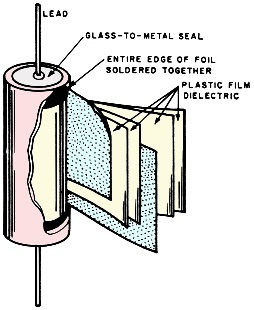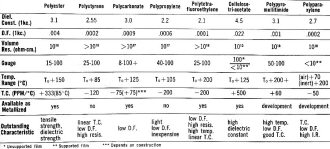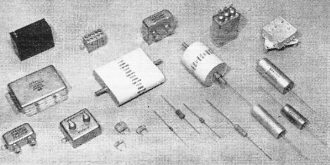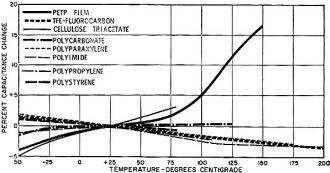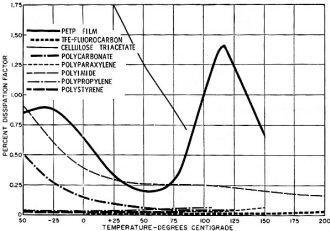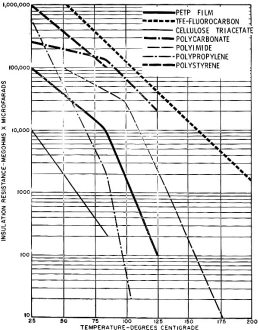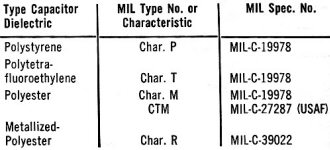Plastic-Film Capacitors
|
|
If you like pronouncing long, complex chemical names, you'll really enjoy this "Plastic Film Capacitors" article from a 1967 issue of Electronics World magazine. It was written by Walter Lamphier of Sprague Electric, a long-time manufacturer of capacitors of all sorts. As of 1992, Vishay has owned Sprague (founded in 1926 by Robert Sprague), but has strategically retained the very familiar Sprague name as part of theirs. Anyway, a lot of information is provided about the relatively new (at the time) plastic-film construction. A contemporary article on the same subject would no doubt include a whole host of new chemical compounds not even invented in 1967. This particular issue of Electronics World reports on a few other kinds of capacitor constructions popular at the time, including paper, ceramic, glass, and electrolytic. Plastic-Film Capacitors
Fig. 1 - Internal details of a metal-encased film capacitor. By Walter C. Lamphier / Senior Product Specialist, Sprague Electric Co. Advances in plastic chemistry have produced an open-ended list of capacitor dielectrics whose electrical characteristics can be tailored to suit almost any particular circuit need. Among the plastic-film dielectrics presently used in capacitors are polystyrene, polypropylene, polytetrafluoroethylene, polyester, polycarbonate. cellulose tri-acetate, polypyromellitimide, and polyparaxylene. The basic construction of capacitors using these materials is quite similar. They may be considered as parallel-plate capacitors which have been rolled into a coil. For the most part, the conducting plates extend from opposite ends of the coil and have leads attached. The capacitor roll is protected from the external environment by a metal case, a plastic housing, or a plastic encapsulation. Fig. 1 shows the basic construction of a typical capacitor which might use any of the these dielectrics. The photograph (next page) shows a number of capacitors which demonstrate the numerous variety of external housings and terminal arrangements in which plastic-film dielectric capacitors are furnished. The dielectric materials mentioned may be used to produce extremely thin sheets which are employed as the separators in plastic-film capacitors. Each material is used in capacitors because some particular characteristic or combination of characteristics of the resulting capacitors is unique and most advantageous for specific circuit applications. Table 1 covers some of the more important physical and electrical properties of these materials. Table I - Characteristics of the various dielectrics which are used in the manufacture of plastic capacitors. Some of the different methods of packaging plastic-film units. Fig. 2 - Capacitance change vs. temperature for various plastics. Fig. 3 - Dissipation factor vs. temperature for various plastics. Polystyrene Polystyrene is a polymer of the aromatic styrene monomer and possesses outstanding electrical characteristics. Using this material, capacitors may be made to capacitive tolerances as close as 0.1 %. They will retain this precise value almost indefinitely, even following moderate temperature changes. The high resistivity and small negative, but linear, temperature coefficient of capacitance make them very useful in analog computers. The two chief limitations to the use of polystyrene capacitors are the 85°C maximum operating temperature and their relatively large size. Polypropylene Polypropylene is an aliphatic polymer of the propylene monomer and possesses outstanding electrical characteristics similar to polystyrene. It is available from high-volume production equipment and hence has the lowest price per pound of any of the organic materials mentioned. Unfortunately, it has some serious limitations because of its physical properties. It has low tensile strength and thus is limited to a minimum thickness of 1.0 mil (0.001") at the present time. Its lack of physical stability prevents it from having the outstanding electrical stability that is characteristic of properly made polystyrene capacitors. Polytetrafluoroethylene Polytetrafluoroethylene (PTFE) is an aliphatic polymer of the fluorinated carbon atom. Its intrinsic insulating properties are the best of ail plastic materials presently used. The highly symmetrical fluorinated carbon atom, as well as a lack of impurities in the material as manufactured. result in the highest resistivity and lowest loss factor of all organic dielectric materials used in capacitors. It also has a small linear negative temperature coefficient of capacitance. PTFE does not melt but may be sintered above 300°C, indicating high bond strength which may be capitalized upon to produce capacitors rated for reliable operation at 200°C. The two most striking drawbacks of TFE-fluorocarbon capacitors are their large size and high cost. The size is greater than that of polystyrene capacitors and the cost is five times as great. Because of these limitations, PTFE capacitors are used as a last resort when the highest insulation resistance possible, a linear temperature coefficient above 85°C, or an operating temperature above 150°C are key parameters. The material is available from several sources here and abroad under such names as Teflon-TFE, Fluon, Halon, and other trademarks. It also has widespread uses in such applications as coating for chemical ware and cooking utensils because it is inert to most chemicals and materials do not adhere to it. Polyester Polyester capacitors are presently the most widely used of all plastic-film capacitors. The most common polyester which is employed is a product of the reaction of terephthalic acid and ethylene glycol. The latter may be familiar as the standard non-boiling automotive antifreeze material. Polyethylene terephthalate was originally developed abroad and its electrical characteristics were first published in 1949. It is not only used as a capacitor dielectric but it is also one of the most widely used synthetic materials for making fibers for weaving cloth. Imperial Chemical Industries, which originated PETP (to use the common abbreviation), markets its capacitor film under the trademark Melinex and its fiber as Terylene. E. I. DuPont de Nemours, which introduced the material into the U. S., calls it Mylar or Dacron for the corresponding applications. A heavier gauge film for photographic purposes is sold under the trademark Cronar by Dupont. Other vendors have recently come on the market with PETP as well, selling it simply as an XX-brand polyester or under other trademarks, such as Celanar, etc. A somewhat similar polyester material with slightly different qualities, polycyclohexylene dimethylene terephthalate (abbreviated as PCHMTP or PMPT), is sold by Eastman Kodak under the trademark Kodar. Polyester, as made by Dupont, was the first dielectric to effectively challenge the use of kraft paper in an important segment of the capacitor field. The material is physically very tough. Moreover, it may be obtained in near-perfect sheets as thin as 0.15 mil (15 gauge), 1/20 the thickness of a typical brunette hair. It exhibits a much greater tolerance toward atmospheric contamination, such as from moisture, than does kraft paper. For this reason, non-hermetically sealed polyester-film capacitors have substantially replaced the conventional "paper tubular." Polyester capacitors must be operated below the corona, or flash-over voltage of air, since voids are always present. As a consequence, alternating voltages above 250 volts r.m.s. and direct voltages above 2500 volts are frequently detrimental to dry-wound polyester capacitors. A further limitation in PETP film is the second-order transition in the material which may occur between 85° and 125°C. Indications are a substantial increase in capacitance, a peak in the loss factor, and a pronounced increase in failure rate cinder d.c. operation. A combination dual dielectric of polyester film and kraft paper with various impregnants, either "solid" or liquid, overcomes some of these problems and increases reliability. These dual dielectric capacitors are very widely employed. Polycarbonate Polycarbonate, while also a polyester, is usually referred to by this generic name. It is formed by reacting bisphenol-A and phosgene. The latter may be remembered as a poisonous gas used in World War I. The KG-polycarbonate material offered by the German firm Farbenfabriken Bayer A. G. has proven to be superior to polycarbonates from other sources when used as a capacitor dielectric. The thickness gauges are approximately the same as those of Mylar-brand PETP. Its handling properties are quite similar; however, polycarbonate does not exhibit the second-order transition characteristic of PETP and retains its excellent electrical qualities at temperatures as high as 140°C. Both the resistivity and loss factor approach the values for polystyrene. The capacitance of polycarbonate units will change about 1% from room temperature over the operating temperature range. The curve or capacitance change with temperature is crescent-shaped with its maximum at about room temperature . Capacitance stability with time is very good but not quite as excellent as that exhibited by polystyrene capacitors. At this time, the two factors that have prevented its use in a major section of the capacitor field are the physical condition of the sheet and the cost of the film, which is more expensive than either paper of PETP-polyester. It should be noted that dual-dielectric capacitors, which balance the characteristics of PETP and polystyrene to achieve an essentially zero temperature coefficient of capacitance over a wide temperature range, in many cases may be replaced by polycarbonate units. Cellulose Tri-Acetate Cellulose tri-acetate (CTA), which is a nearly completely acetylated cellulose, has been well known for many years. Straight cellulose acetate and cellulose acetate butyrate have also been used as capacitor dielectrics but have been substantially replaced by polyester. Cellulose tri-acetate, however, may be manufactured in film as thin as 4 gauge or 0.00004". The smallest capacitor which can be manufactured from CTA film is 1/3 the volume of the smallest equivalent PETP capacitor. Electrical properties of the cellulose tri-acetate capacitors are adequate for most requirements at temperatures up to 85°C but are a limitation on their use at higher temperatures. Polypyromellitimide Polypyromellitimide film is made from a resin resulting from the condensation reaction of pyromellitic dianhydride and an aromatic diamine. This unique organic polymer, sold by DuPont under the trademark Kapton-H polyimide, is capable of being used over a very wide temperature range and is highly stable. Its electrical characteristics approach those of TFE-fluorocarbon except that the temperature coefficient of capacitance is positive and not precisely linear. The material presents a number of exciting possibilities to the capacitor designer and user; but its ultimate value will best be determined after some history in capacitor production when it has passed the pilot-plant stage, production problems have been solved, and prices have been firmed. This should not be too far in the future. Polyparaxylene Polyparaxylene polymer may be deposited on electrode in extremely thin films. It is consistent with the other highly priced plastics mentioned previously in yielding a dielectric strength of several thousand volts per mil. Capacitor data to this time is quite limited because the material is still in the final stages of development for this application. Available information does hold out the prospect of a substantial reduction in capacitor sizes for uses above 125°C. Because this film can be vapor deposited directly onto the metal electrodes as a pure uniform polymer in thicknesses one-third that of free film dielectrics, stable devices having less than one-fifth the size of polystyrene capacitors of equivalent electrical rating can be produced. Comparisons Capacitors produced from these materials are compared in a number of ways when selecting the proper type to best meet circuit needs. The curves given in Figs. 2, 3, and 4, showing variation in capacitance, dissipation factor, and insulation resistance to temperature, illustrate the type of data used for this purpose. In addition to these fundamentals, two other features of organic-film capacitors must be taken into consideration. Of the eight materials mentioned, polystyrene has not been extensively available or used in the metallized form. Thin sheets of polystyrene must have very low voltage ratings, and the basic size problem which exists with capacitors made from this material becomes amplified. Both TFE-fluorocarbon and polyparaxylene can be deposited on electrodes by vacuum techniques which permit film thicknesses of less than 1000 Angstrom units. These techniques are still in the embryonic stages but do present the possibility of low-voltage film capacitors in the future being minified to approach the sizes, in some cases, of aluminum electrolytic capacitors. As previously mentioned, two different films may be used together in a capacitor winding, either in series or in parallel within the same roll. The resultant compromise in electrical characteristics can be forecast from curves of Figs. 2, 3, and 4. The PS/PETP combination, which has substantially zero capacitance change from 0°C to 80°C, is the best in this respect of any known capacitor, including the so-called NPO ceramics. MIL Spec One measure of the acceptance of a new type of capacitor in industry is found in the status of its Military Specification. MIL Specs are written only after a capacitor has had some usage by suppliers of military electronic equipment. A rule of thumb might be that a MIL Spec is generated after two to three years of significant and successful usage. Keeping this in mind, Table 2 may be of interest, setting forth as it does the present specification status in the Department of Defense of capacitors which are currently manufactured from the organic plastic materials discussed in this article.
Posted September 7, 2022 |
|

